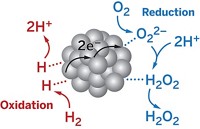Advertisement
Grab your lab coat. Let's get started
Welcome!
Welcome!
Create an account below to get 6 C&EN articles per month, receive newsletters and more - all free.
It seems this is your first time logging in online. Please enter the following information to continue.
As an ACS member you automatically get access to this site. All we need is few more details to create your reading experience.
Not you? Sign in with a different account.
Not you? Sign in with a different account.
ERROR 1
ERROR 1
ERROR 2
ERROR 2
ERROR 2
ERROR 2
ERROR 2
Password and Confirm password must match.
If you have an ACS member number, please enter it here so we can link this account to your membership. (optional)
ERROR 2
ACS values your privacy. By submitting your information, you are gaining access to C&EN and subscribing to our weekly newsletter. We use the information you provide to make your reading experience better, and we will never sell your data to third party members.
Synthesis
Diamond Drives Chemistry, With Help From Light
Surface Science: Energetic photoemitted electrons mediate reductions
by Mitch Jacoby
July 15, 2014

A simple light-driven process might open the door to reactions that are not easily mediated by other means, according to chemists at the University of Wisconsin, Madison. By way of example, they show that the strategy could lead to an inexpensive way to convert the greenhouse gas carbon dioxide to commercially valuable products.
The team capitalized on a property of hydrogen-capped diamond, a common form of the material, that causes it to emit electrons when irradiated with ultraviolet light. The group, which includes Linghong Zhang and Robert J. Hamers, showed that shining UV light on inexpensive, commercial-grade diamond that is immersed in an aqueous CO2 solution liberates electrons that quickly interact with water molecules and become solvated. These energetic species then serve as potent reducing agents that can react with CO2 and convert it to CO, a compound used in chemical synthesis and other industrial processes (Angew. Chem. Int. Ed. 2014, DOI: 10.1002/anie.201404328).
The Wisconsin team stresses that conventional electrochemical and photochemical processes, both of which have been studied for CO2 reduction, require reactants to bond to a surface to react. In contrast, the solvated electron approach does not require surface adsorption. It is based instead on a potentially simpler process—direct emission of electrons into water and solution-phase chemistry.
On the basis of electrochemical measurements, spectroscopy and chromatography analysis, and isotope labeling experiments, the team shows that their light-induced method reduces CO2 with high selectivity (>95%) and produces a minimal quantity of hydrogen, a common by-product of CO2 reduction. Furthermore, they conclude that the reaction occurs by way of a relatively uncommon 1-electron reduction mechanism. That process, which converts CO2 to the radical anion CO2•- en route to forming CO, has a large potential barrier and is inaccessible to other methods. Because it’s easy to produce energetic solvated electrons from diamond, this process might be used to drive other types of reduction reactions.
Hamers group has “shaken up the semiconductor surface chemistry world” by showing that photoemitted electrons can stimulate surface reactions, in this case reducing CO2 very selectively, says University of Alberta chemistry professor Jillian M. Buriak. She adds that the group uses semiconductor physics in “such a creative manner, making hard reactions look easy.”




Join the conversation
Contact the reporter
Submit a Letter to the Editor for publication
Engage with us on Twitter